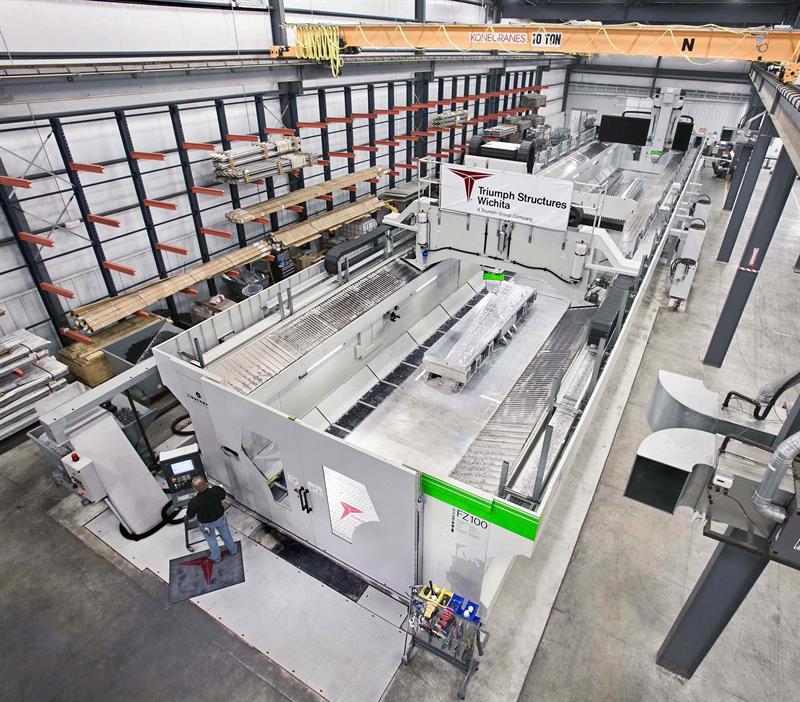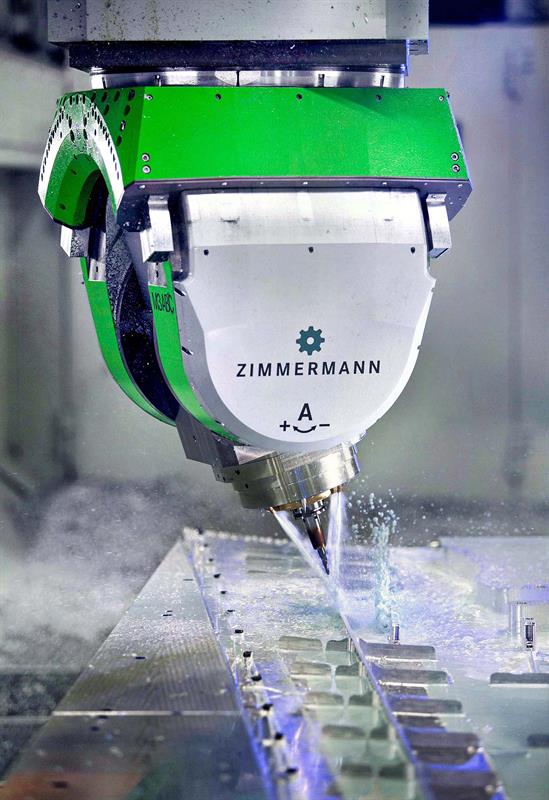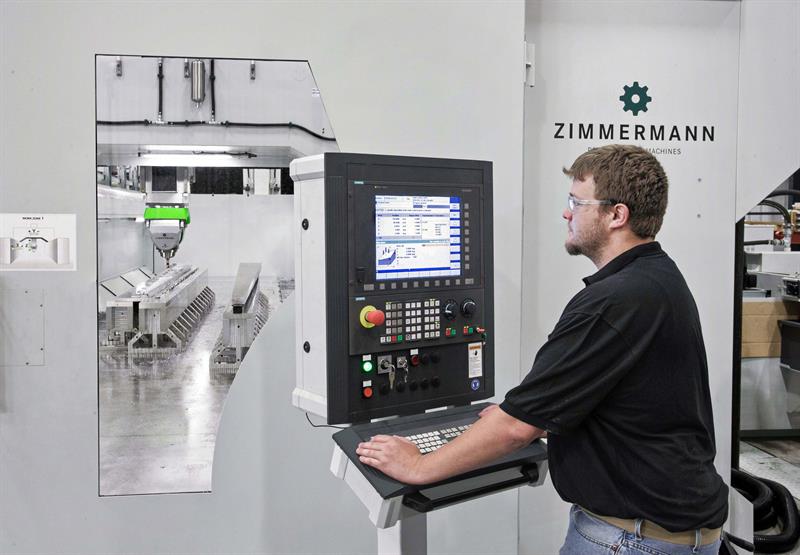Triumph Structures - Wichita is specialises in high speed machining and sub-assembly of aluminium and titanium structural airframe components having wall thicknesses down to 0.508 mm (0.020 in). The company manufactures wing spars and stringers but additionally smaller sections, such as bulkheads and landing gear, which means that fast, reliable and versatile machine tools are required.
The company already had 21 5-axis CNC machining centres for producing components up to 22 ft long (6.7056 m), and more than 20 other 3- and 4-axis machines on site, but in moving to be able to machine larger parts, Triumph Structures - Wichita opted to have an F Zimmermann FZ100 single-gantry machine modified by its US supplier, making it available to serve multiple purposes.
Primarily used for very long parts and employing volumetric compensation to manage material expansion, as well as tool tip position, over long cutting cycles often lasting several days, it was also thought that the same machine might also be capable of running multiple smaller parts or, alternatively, operate along the entire machine bed with both heads working in tandem on the same part. That last scenario would demand both collision avoidance between the gantries, as well as consistency of machining at points on the component surface where the two machining heads’ tools intersect.
Triumph Structures - Wichita approached Zimmermann Inc in Novi, Michigan, to request that it modify the an FZ100 single-gantry machine to include a second gantry. Each would be equipped with an independent Siemens Sinumerik 840D sl control and an M3 ABC fork-type milling head with three rotary CNC axes to provide, via both gantries, simultaneous 6-axis cutting.
The ±15° B-axis avoids the ‘pole position’ problem of traditional 2-axis A/C rotary-tilt heads, whereby when A is at 0° it cannot move. The 3-axis head is able to swivel, tilt and incline to any angle and, as cutter chatter on the surface of a component due to excessive C-axis rotation is eliminated, provides constant feedrate capability, significantly reducing machining times and improving component surface finish.
A removable partition at the midpoint of the machine bed allows the machine to operate as two machine tools when required. Without the partition, the machine bed accepts parts up to 80 feet long and processes them using the twin heads working in tandem and monitored for collision avoidance by the two CNCs.

Triumph Structures - Wichita's modified F Zimmerman FZ100, which sports two gantries and is able to employ both on a single component, without fear of toolpath mismatch
Built over an 18-month period, the issue of intersecting toolpaths caused by machining the same parts with two heads was easily addressed and resolved using the Siemens CNC volumetric compensation feature, which sees execution of machining based on actual tool tip position. Surface integrity on the workpiece is preserved, while operator and machine safety are also delivered.
Says Harry Thurmond, president of Triumph Structures – Wichita: “The design of the Zimmermann head in combination with the look-ahead feature of the CNC provides significant speed advantages during typical aerospace structure machining.
“Over long runs, it can translate into cycle time reductions of 35% or more, especially as subsequent deburring and polishing are not required.
“We routinely achieve better than 125 RMS finish on inside pocket surfaces and up to a 32 RMS on the outside of the Series 7000 aluminium structurals we produce.”
On longer runs, the chilled coolant used in the Zimmermann is helpful in minimising thermal expansion of the material, he adds, a critical factor in long-run machining work. The machine is also equipped with probes so that it can be used as a CMM for in-process measurement of workpieces.
Another feature is DemTec composite fill in the machine base and side walls that offer enhanced stability and vibration damping. Two backlash-free rack-and-pinion drives are sealed from contamination and guided on both sides. All axes have feed rates up to 60 m/min and accelerations up to 4 m/s2. Spindles are rated at 73 kW/27,000 rpm and each head is served by a 60-position toolchanger.

The 3M ABC head allows machining without the limitations of traditional 2-axis heads
Triumph Structures - Wichita integrates the machines into the company’s network, and through a remote monitoring feature in the Sinumerik 840D SL CNC, Zimmermann can log all conditions on the machine in real-time.
Concludes Thurmond: “We have grown steadily over the last decades, since our incorporation of 5-axis work in the 1990s, and were ready to jump to a new level of competence for our customers, which represent the top players in both commercial and military aircraft.
“Our part length capability had been 22 ft [6.7056 m]and we were committed to expanding it to compete in the 40 to 80 ft range [12.192- 24.384 m].
“As with all efficient aerospace structure machining, material removal rates have to be extremely high. We can start with a 5,600 lb [2,540 kg] billet that ends up weighing 100 lb [45.3 kg].
“The Zimmermann dual-gantry machine addresses all of these requirements and is helping us to move our business forward.”

Triumph Structures - Wichita has integrated its bespoke FZ100 into its network, allowing Zimmermann to log all conditions on the machine in real-time



